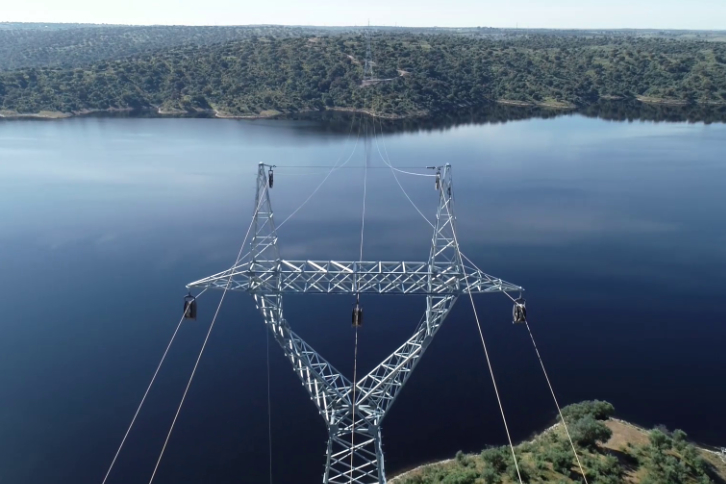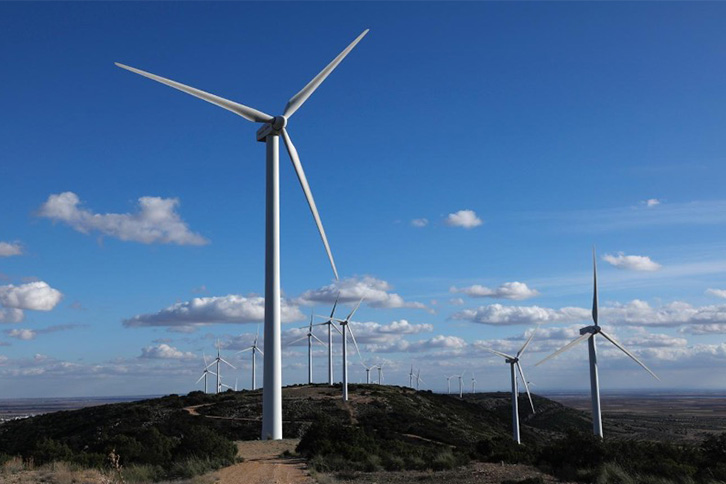Electricity networks are the key to the future of the energy sector. Delivering clean energy made available through renewables and storage systems will represent another step towards safe and sustainable electricity consumption.
Hard-to-abate sectors
A deep dive into hard-to-abate sectors: types, characteristics and challenges
Urgent action is needed to address the so-called ‘hard-to-abate’ sectors, areas that are difficult to decarbonise and where reducing emissions is particularly challenging. Iberdrola is contributing to this challenge with its focus on green hydrogen, as well as electrification and industrial innovation.

Hard-to-abate sectors refer to industries where reducing carbon emissions is particularly difficult due to the nature of their processes and their heavy reliance on fossil fuels. These industries include shipping, aviation, heavy transport and steel and cement production, where the high energy inputs required and specific chemical reactions make electrification difficult. According to the International Renewable Energy Agency (Irena), these sectors are not currently on track to achieve net zero emissions by 2050, which is a key objective of the Paris Climate Agreement with regard to energy transition.
What is hard-to-abate? A deep insight into the affected sectors
Hard-to-abate sectors depend on processes or energy sources that are very difficult to make carbon neutral with current technology, and thus achieve sustainability. They rely on the combustion of fossil fuels, for example, or chemical reactions that release greenhouse gases into the atmosphere. They include sectors such as shipping, aviation, heavy-duty trucking, and the production of iron and steel, as well as chemicals and petrochemicals.
According to a 2024 report from the International Renewable Energy Agency (Irena), none of these hard-to-abate sectors is currently on track to reach net-zero emissions by 2050, which is the objective of the 2015 Paris Agreement in a bid to limit global temperature increases to 1.5ºC since the start of the industrial era. Hard-to-abate sectors are a major obstacle on the path to tackling climate change, given that they currently account for one-third of global energy-related emissions and one-fifth of total CO2 emissions.
What’s more, emissions from these areas are expected to grow by more than 50% from here to 2050 under a “business-as-usual” (BAU) scenario – i.e. one where no more effort is made to curb greenhouse gas emissions.
Some key figures
Hard-to-abate sectors pose a major challenge in the fight against greenhouse gas emissions and the resulting climate change. This is shown by figures reflecting the scale of the challenge, according to a report published in July 2024 by Citi.
-
31% of global GHG emissions come from hard-to-abate sectors
-
12 years until methane disappears from the atmosphere
-
60% of energy generated today comes from fossil fuels
-
3% of energy-related GHG emissions come from maritime transport
What are hard-to-abate emissions?
Hard-to-abate emissions refer to the actual pollutants that are released into the Earth’s atmosphere by these processes, such as carbon dioxide or methane. The processes associated with hard-to-abate industries require very high amounts of energy, and therefore the combustion of fossil fuels with the resultant emission of greenhouse gases. What’s more, hard-to-abate emissions are often produced as a byproduct of chemical reactions.
Characteristics and challenges of hard-to-abate emissions
Greenhouse gases emitted by the hard-to-abate sectors pose major challenges, as they can remain in the atmosphere from a few years in some cases to many thousands of years in others. While in other sectors emissions can be reduced through the transition to cleaner technologies, such as renewable energy, emissions from the hard-to-abate sectors are characterised by the difficulty of avoiding the production of greenhouse gases.
Which sectors are hard to decarbonise?
The hard-to-abate or hard-to-decarbonise sectors represent a major challenge for emission reductions due to their high dependence on fossil fuels and the complexity of their industrial processes. In heavy-duty transport, vehicles emit a quarter of the entire transport sector's CO₂; in heavy industry, the production of steel, cement and chemicals requires high temperatures that generate emissions. What’s more, sectors such as aviation and shipping, which are critical to the global economy, present difficulties for the transition to cleaner energy alternatives due to the energy density required.
1 Heavy industry

In this sector, the production of steel, cement and chemicals produces hard-to-abate emissions, both from the energy that is required to produce the high temperatures needed for these processes, as well as the chemical reactions involved. Clinker, for example, is one of the main ingredients in cement. It is produced by heating limestone to extremely high temperatures, an action that releases the carbon in the stone. This element then combines with oxygen in the atmosphere, forming the greenhouse gas carbon dioxide (CO₂).
2 Aviation

Passenger planes and cargo aircraft require highly energy-dense fossil fuels, such as kerosene. According to Irena, the global aviation sector accounted for 10% of the world’s transport-related energy consumption in 2022, and 3% of total global energy consumption. As a result, the sector is a major contributor to CO₂ emissions, equivalent to 2 to 3% of global emissions and 10% of all transport-related emissions, according to Irena. The formation of contrails – vapour trails composed of water in the form of ice crystals – from plane engines also contributes to global warming, as they trap radiation from the Earth and reflect solar radiation.
3 Shipping

The shipping sector is currently very dependent on low-grade fossil fuels such as heavy fuel oil (HFO) and marine diesel oil, but is actually among one of the least carbon-intensive modes of transport. That said, the sector is still a major emitter of greenhouse gases given its sheer scale. Shipping accounts for 3% of total global energy consumption, and 10% of all transport-related energy consumption, according to Irena.
4 Heavy-duty trucking

Vehicles used for transporting goods emit almost a quarter of all the carbon dioxide emissions from the transport sector, outstripping the international aviation and shipping industries combined. Heavy-duty trucks use almost exclusively energy-rich fossil fuels such as diesel, petrol and natural gas.
Characteristics and challenges of hard-to-decarbonise sectors
Electrification of hard-to-abate industries, a key step towards the energy transition
Energy transition: the path towards electrification
The energy transition has been a process of replacing fossil fuels with electricity from renewable energy sources. This has been the groundwork that has facilitated the electrification process we are currently undergoing.
Discover the energy transitionWhat is electrification?
Electricity networks are the key to the future of the energy sector. Delivering clean energy made available through renewables and storage systems will represent another step towards safe and sustainable electricity consumption.
Energy transition: the path towards electrification
The energy transition has been a process of replacing fossil fuels with electricity from renewable energy sources. This has been the groundwork that has facilitated the electrification process we are currently undergoing.
Discover the energy transitionHow can hydrogen play a role in hard-to-abate sectors?
Hydrogen is likely to play a key role in reducing emissions within hard-to-abate sectors, and achieving the objectives of the Paris Climate Agreement. The element, which is colourless, odourless and highly flammable, gives off no emissions when it burns, and could be key to decarbonising hard-to-abate sectors such as aviation, and steel and cement manufacturing.
Hydrogen can also be used to produce ammonia, a chemical that is a key component of fertilisers. Currently, ammonia is produced using fossil fuels, but substituting them for hydrogen could reduce the emissions from the agricultural sector by decarbonising fertiliser production.
What’s more, ammonia could be used as a fuel in existing marine engines. Given that it burns without producing emissions, it could also be an alternative fuel in the hard-to-abate sector of shipping, replacing polluters such as heavy fuel oil.
In industry, hydrogen could replace fossil fuels, given that it can be used to produce high temperatures needed in kilns used during the process of making cement. Hydrogen could also replace the coal used in blast furnaces for the iron ore reduction process that is essential to making steel.
The production of hydrogen, meanwhile, can also be done cleanly. Renewable energy can be used to produce the element via electrolysis.
A combination of technological advancements and government policies will be needed if clean hydrogen is to be adopted in hard-to-abate sectors, shifting them away from fossil fuels.
The challenges of using hydrogen in hard-to-abate sectors
According to the United Nations Economic Commission for Europe (UNECE), a lack of government policies is preventing an increased demand for hydrogen, and this is needed before the value chain for the fuel can grow. The International Energy Agency, meanwhile, reports that just 5% of announced hydrogen projects make it to the final investment decision.
There are, according to UNECE, concerns about the cost, technological challenges, risks, regulatory environment, geopolitical uncertainties and the lack of infrastructure needed to deliver hydrogen to end users. Currently, just 0.1% of hydrogen demand is for new applications in heavy industries, when this figure would need to be 33% by 2030 in order to meet the Net Zero target for mid-century.
Other challenges include regulatory fragmentation. According to a report from international law firm White & Case, in Europe there are jurisdictional variations in everything from planning and competition laws, to specifications for pipelines, all of which can be an obstacle for implementing hydrogen investments.
Cost is another factor, with a huge gap between the expense of producing renewable hydrogen, and low carbon or traditional fossil fuel hydrogen.
Our commitment to electrification in hard-to-abate sectors
12 September 2024
The future of hard-to-abate industries and sectors
Technology is going to play a key role in the future of hard-to-abate industries and sectors if emissions are to be brought down. These new advances will likely include more advanced biofuels or carbon-capture processes, and there will need to be attempts to limit demand for commodities from these industries. Here are some examples of the changes that could be seen in a bid to reach net zero in these areas.
More about hard-to-abate sectors





















